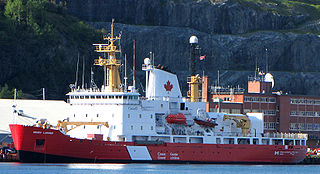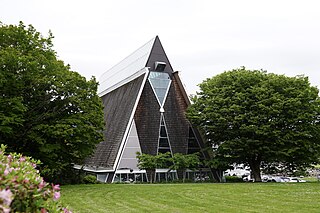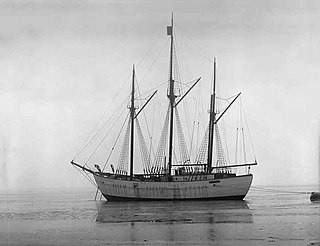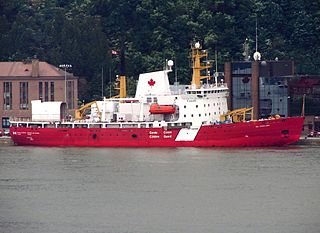
The Northwest Passage (NWP) is the sea lane between the Atlantic and Pacific oceans through the Arctic Ocean, along the northern coast of North America via waterways through the Canadian Arctic Archipelago. The eastern route along the Arctic coasts of Norway and Siberia is accordingly called the Northeast Passage (NEP). The various islands of the archipelago are separated from one another and from Mainland Canada by a series of Arctic waterways collectively known as the Northwest Passages, Northwestern Passages or the Canadian Internal Waters.

Henry Asbjørn Larsen was a Norwegian-Canadian Arctic explorer. Larsen was born on a small island, Herføl, south of Fredrikstad in Norway. Like his hero, Roald Amundsen, he became a seaman. Larsen immigrated to Canada, and became a British subject in 1927. In 1928, he joined the Royal Canadian Mounted Police (RCMP).

CCGS Henry Larsen is a Canadian Coast Guard Improved Pierre Radisson-class icebreaker serving in the Newfoundland and Labrador region and based in St John's, Newfoundland and Labrador. Entering service in 1988, Henry Larsen is the fourth ship and of an improved design over the rest of the ships in her class. The ship operates in the Arctic Ocean during summer months.

Gjøa was the first vessel to transit the Northwest Passage. With a crew of six, Roald Amundsen traversed the passage in a three-year journey, finishing in 1906.

Boothia Peninsula is a large peninsula in Nunavut's northern Canadian Arctic, south of Somerset Island. The northern part, Murchison Promontory, is the northernmost point of mainland Canada.

The Vancouver Maritime Museum is a maritime museum devoted to presenting the maritime history of Vancouver, British Columbia, Canada, and the Canadian Arctic. Opened in 1959 as a Vancouver centennial project, it is located within Vanier Park just west of False Creek on the Vancouver waterfront. The museum is affiliated with CMA, CHIN, and Virtual Museum of Canada.

The S/Y Sedna IV is a 51-metre (167 ft) three-masted schooner which has been used for scientific expeditions and the filming of documentaries.

CCGS Labrador was a Wind-class icebreaker. First commissioned on 8 July 1954 as Her Majesty's Canadian Ship (HMCS) Labrador in the Royal Canadian Navy (RCN), Captain O.C.S. "Long Robbie" Robertson, GM, RCN, in command. She was transferred to the Department of Transport (DOT) on 22 November 1957, and re-designated Canadian Government Ship (CGS) Labrador. She was among the DOT fleet assigned to the nascent Canadian Coast Guard (CCG) when that organization was formed in 1962, and further re-designated Canadian Coast Guard Ship (CCGS) Labrador. Her career marked the beginning of the CCG's icebreaker operations which continue to this day. She extensively charted and documented the then-poorly-known Canadian Arctic, and as HMCS Labrador was the first ship to circumnavigate North America in a single voyage. The ship was taken out of service in 1987 and broken up for scrap in 1989.

Effie M. Morrissey is a schooner skippered by Robert Bartlett that made many scientific expeditions to the Arctic, sponsored by American museums, the Explorers Club and the National Geographic Society. She also helped survey the Arctic for the United States Government during World War II. She is currently designated by the United States Department of the Interior as a National Historic Landmark as part of the New Bedford Whaling National Historical Park. She is the State Ship of Massachusetts.

Crystal Serenity is a cruise ship owned by Crystal Cruises before the line went out business. Crystal Serenity was built in 2003 by STX Europe in St. Nazaire. She operated together with her older fleetmate, Crystal Symphony, offering around the world voyages.

Maud, named for Queen Maud of Norway, was a ship built for Roald Amundsen for his second expedition to the Arctic. Designed for his intended voyage through the Northeast Passage, the vessel was built in Asker, a suburb of the capital, Oslo.

Bowdoin is a historic schooner built in 1921 in East Boothbay, Maine, at the Hodgdon Brothers Shipyard. Designed by William H. Hand, Jr. under the direction of explorer Donald B. MacMillan, the gaff-rigged vessel is the only American schooner built specifically for Arctic exploration. She has made 29 trips above the Arctic Circle in her life, three since she was acquired by the Maine Maritime Academy as a sail training ship in 1988. She is currently owned by the Academy, located in Castine, Maine, and is named for Bowdoin College.

The Sail and Life Training Society (SALTS), founded in 1974, is a non-profit Christian organization based in Victoria, British Columbia. SALTS provides sail training and life lessons for 1,700 young people each year on tall ships and provides a valued link to the area's maritime heritage. Currently, SALTS administrative offices are located on Herald Street in downtown Victoria, with a shop space located nearby in the Rock Bay area.
CCGS Simon Fraser was a buoy tender operated by the Canadian Coast Guard. The vessel entered service in 1960 with the Department of Transport's Marine Fleet, before being transferred to the newly formed Canadian Coast Guard in 1962. The buoy tender served on both coasts of Canada and was used for search and rescue duties along the West Coast of Canada. The ship was loaned to the Royal Canadian Mounted Police in 2000 and transited the Northwest Passage, circumnavigating North America in the process. The ship was taken out of service in 2001 and sold to private interests. In 2006, the vessel reappeared as a yacht using the same name.
RCMP Nadon is a Commissioner-class high-speed patrol vessel previously operated by the Royal Canadian Mounted Police's Marine Division. The vessel, designed by Robert Allan Ltd. and built by Shore Boat Builders, is an aluminium-hulled 17.7-metre (58 ft) planing catamaran, capable of speeds of up to 36 knots.
Réal Bouvier was a Canadian navigator and a Quebec journalist.

Aklavik was a small cargo vessel the Hudson's Bay Company used to carry supplies to, and furs from, its outposts in the high Arctic. She was active in the first half of the 20th century.

The Pierre Radisson-class icebreakers, also known as R-class icebreakers, are a class of four icebreakers constructed for and operated by the Canadian Coast Guard. The Canadian Coast Guard designates the four ships in the class as medium icebreakers. Built in two phases, the first three ships, Pierre Radisson, Franklin and Des Groseilliers, were built to a common design. The fourth, Henry Larsen was built to a modified design and is considered a subclass, the Improved R-class icebreaker. Franklin was later renamed Sir John Franklin before undergoing a re-design for use primarily as an Arctic research vessel. Upon the vessel's return to service, the ship was once again renamed Amundsen. All the vessels are named for people who sailed through Canada's northern waters. The class operates in the Arctic Ocean in the summer, patrolling, icebreaking and research missions.

Cape Farrar is a cape located along the Boothia Peninsula of the Kitikmeot Region near Taloyoak in the Canadian province of Nunavut, approximately 2,900 km northwest of Ottawa.




















